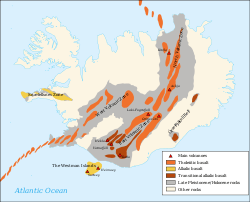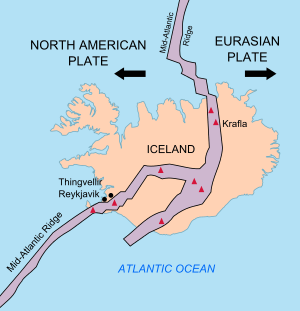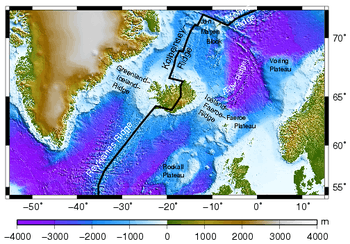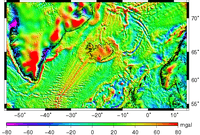Iceland hotspot
The Iceland hotspot is a hotspot which is partly responsible for the high volcanic activity which has formed the Iceland Plateau and the island of Iceland.



Iceland is one of the most active volcanic regions in the world, with eruptions occurring on average roughly every three years (in the 20th century there were 39 volcanic eruptions on and around Iceland). About a third of the basaltic lavas erupted in recorded history have been produced by Icelandic eruptions. Notable eruptions have included that of Eldgjá, a fissure of Katla, in 934 (the world's largest basaltic eruption ever witnessed), Laki in 1783 (the world's second largest), and several eruptions beneath ice caps, which have generated devastating glacial bursts, most recently in 2010 after the eruption of Eyjafjallajökull.
Iceland's location astride the Mid-Atlantic Ridge, where the Eurasian and North American Plates are moving apart, is partly responsible for this intense volcanic activity, but an additional cause is necessary to explain why Iceland is a substantial island while the rest of the ridge mostly consists of seamounts, with peaks below sea level.
As well as being a region of higher temperature than the surrounding mantle, it is believed to have a higher concentration of water. The presence of water in magma reduces the melting temperature, which may also play a role in enhancing Icelandic volcanism.
Theories of causation
There is an ongoing discussion about whether the hotspot is caused by a deep mantle plume or originates at a much shallower depth.[1] Recently, seismic tomography studies have found seismic wave speed anomalies under Iceland, consistent with a hot conduit 100 km across that extends to the lower mantle.[2]
Some geologists have questioned whether the Iceland hotspot has the same origin as other hotspots, such as the Hawaii hotspot. While the Hawaiian island chain and the Emperor Seamounts show a clear time-progressive volcanic track caused by the movement of the Pacific Plate over the Hawaiian hotspot, no such track can be seen at Iceland.
It is proposed that the line from Grímsvötn volcano to Surtsey shows the movement of the Eurasian Plate, and the line from Grímsvötn volcano to Reykjanes volcanic belt shows the movement of the North American Plate.[3]
Mantle plume theory
The Iceland plume is a postulated upwelling of anomalously hot rock in the Earth's mantle beneath Iceland. Its origin is thought to lie deep in the mantle, perhaps at the boundary between the core and the mantle at approximately 2,880 km depth. Opinions differ as to whether seismic studies have imaged such a structure.[4] In this framework, the volcanism of Iceland is attributed to this plume, according to the theory of W. Jason Morgan.[5]
It is believed that a mantle plume underlies Iceland, of which the hotspot is thought to be the surface expression, and that the presence of the plume enhances the volcanism already caused by plate separation. Additionally, flood basalts on the continental margins of Greenland and Norway, the oblique orientation of the Reykjanes Ridge segments to their spreading direction, and the enhanced igneous crustal thickness found along the southern Aegir and Kolbeinsey Ridges may be results of interaction between the plume and the Mid-Atlantic Ridge.[6] The plume stem is believed to be quite narrow, perhaps 100 km across and extending down to at least 400–650 km beneath the Earth's surface, and possibly down to the core-mantle boundary, while the plume head may be > 1,000 km in diameter.[6][7]
It is suggested that the lack of a time-progressive track of seamounts is due to the location of the plume beneath the thick Greenland craton for ~ 15 Myr after continental breakup,[8] and the later entrenchment of the plume material into the northern Mid-Atlantic Ridge following its formation.[6]
Geological history
According to the plume model, the source of Icelandic volcanism lies deep beneath the center of the island. The earliest volcanic rocks attributed to the plume are found on both sides of the Atlantic. Their ages have been determined to lie between 58 and 64 million years. This coincides with the opening of the north Atlantic in the late Paleocene and early Eocene, which has led to suggestions that the arrival of the plume was linked to, and has perhaps contributed to, the breakup of the[9] North Atlantic continent. In the framework of the plume hypothesis, the volcanism was caused by the flow of hot plume material initially beneath thick continental lithosphere and then beneath the lithosphere of the growing ocean basin as rifting proceeded. The exact position of the plume at that time is a matter of disagreement between scientists,[10] as is whether the plume is thought to have ascended from the deep mantle only at that time or whether it is much older and also responsible for the old volcanism in northern Greenland, on Ellesmere Island, and at Alpha Ridge in the Arctic.[11]
As the northern Atlantic opened to the east of Greenland during the Eocene, North America and Eurasia drifted apart; the Mid-Atlantic Ridge formed as an oceanic spreading center and a part of the submarine volcanic system of mid-oceanic ridges.[12] The initial plume head may have been several thousand kilometers in diameter, and it erupted volcanic rocks on both sides of the present ocean basin to produce the North Atlantic Igneous Province. Upon further opening of the ocean and plate drift, the plume and the mid-Atlantic Ridge are postulated to have approached one another, and finally met. The excess magmatism that accompanied the transition from flood volcanism on Greenland, Ireland and Norway to present-day Icelandic activity was the result of ascent of the hot mantle source beneath progressively thinning lithosphere, according to the plume model, or a postulated unusually productive part of the mid-ocean ridge system.[13] Some geologists have suggested that the Iceland plume could have been responsible for the Paleogene uplift of the Scandinavian Mountains by producing changes in the density of the lithosphere and asthenosphere during the opening of the North Atlantic.[14] To the south the Paleogene uplift of the English chalklands that resulted in the formation of the Sub-Paleogene surface has also been attributed to the Iceland plume.[15]
An extinct ridge exists in western Iceland, leading to the theory that the plume has shifted east with time. The oldest crust of Iceland is more than 20 million years old and was formed at an old oceanic spreading center in the Westfjords (Vestfirðir) region. The westward movement of the plates and the ridge above the plume and the strong thermal anomaly of the latter caused this old spreading center to cease 15 million years ago and lead to the formation of a new one in the area of today's peninsulas Skagi and Snæfellsnes; in the latter there is still some activity in the form of the Snæfellsjökull volcano. The spreading center, and hence the main activity, have shifted eastward again 7–9 million years ago and formed the current volcanic zones in the southwest (Reykjanes, Hofsjökull) and northeast (Tjörnes). Presently, a slow decrease of the activity in the northeast takes place, while the volcanic zone in the southeast (Katla, Vatnajökull), which was initiated 3 million years ago, develops.[16] The reorganisation of the plate boundaries in Iceland has also been attributed to microplate tectonics.[13]

Challenges to the plume model
The weak visibility of the postulated plume in tomographic images of the lower mantle and the geochemical evidence for eclogite in the mantle source have led to the theory that Iceland is not underlain by a mantle plume at all, but that the volcanism there results from processes related to plate tectonics and is restricted to the upper mantle.[17][18]
Subducted ocean plate
According to one of those models, a large chunk of the subducted plate of a former ocean has survived in the uppermost mantle for several hundred million years, and its oceanic crust now causes excessive melt generation and the observed volcanism.[13] This model, however, is not backed by dynamical calculations, nor is it exclusively required by the data, and it also leaves unanswered questions concerning the dynamical and chemical stability of such a body over that long period or the thermal effect of such massive melting.
Upper mantle convection
Another model proposes that the upwelling in the Iceland region is driven by lateral temperature gradients between the suboceanic mantle and the neighbouring Greenland craton and therefore also restricted to the upper 200–300 km of the mantle.[19] However, this convection mechanism is probably not strong enough under the conditions prevailing in the north Atlantic, with respect to the spreading rate, and it does not offer a simple explanation for the observed geoid anomaly.
Geophysical and geochemical observations
Information about the structure of Earth's deep interior can be acquired only indirectly by geophysical and geochemical methods. For the investigation of postulated plumes, gravimetric, geoid and in particular seismological methods along with geochemical analyses of erupted lavas have proven especially useful. Numerical models of the geodynamical processes attempt to merge these observations into a consistent general picture.
Seismology
An important method for imaging large-scale structures in Earth's interior is seismic tomography, by which the area under consideration is "illuminated" from all sides with seismic waves from earthquakes from as many different directions as possible; these waves are recorded with a network of seismometers. The size of the network is crucial for the extent of the region which can be imaged reliably. For the investigation of the Iceland Plume, both global and regional tomography have been used; in the former, the whole mantle is imaged at relatively low resolution using data from stations all over the world, whereas in the latter, a denser network only on Iceland images the mantle down to 400–450 km depth with higher resolution.
Regional studies from the 1990s and 2000s show that there is a low seismic-wave-speed anomaly beneath Iceland, but opinion is divided as to whether it continues deeper than the mantle transition zone at roughly 600 km depth.[12][20][21] The velocities of seismic waves are reduced by up to 3% (P waves) and more than 4% (S waves), respectively. These values are consistent with a small percentage of partial melt, a high magnesium content of the mantle, or elevated temperature. It is not possible to unambiguously separate out which effect causes the observed velocity reduction.
Geochemistry
Numerous studies have addressed the geochemical signature of the lavas present on Iceland and in the north Atlantic. The resulting picture is consistent in several important respects. For instance, it is not contested that the source of the volcanism in the mantle is chemically and petrologically heterogeneous: it contains not only peridotite, the principal mantle rock type, but also eclogite, a rock type that originates from the basalt in subducted slabs and is more easily fusible than peridotite.[22][23] The origin of the latter is assumed to be metamorphosed, very old oceanic crust which sank into the mantle several hundreds of millions of years ago during the subduction of an ocean, then upwelled from deep within the mantle.
Studies using the major and trace-element compositions of Icelandic volcanics showed that the source of present-day volcanism was about 100 °C greater than that of the source of mid-ocean ridge basalts.[24]
The variations in the concentrations of trace elements such as helium, lead, strontium, neodymium, and others show clearly that Iceland is compositionally distinct from the rest of the north Atlantic. For instance, the ratio of He-3 and He-4 has a pronounced maximum on Iceland, which correlates well with geophysical anomalies, and the decrease of this and other geochemical signatures with increasing distance from Iceland indicate that the extent of the compositional anomaly reaches about 1,500 km along the Reykjanes Ridge and at least 300 km along the Kolbeinsey Ridge.[25] Depending on which elements are considered and how large the area covered is, one can identify up to six different mantle components, which are not all present in any single location.
Furthermore, some studies show that the amount of water dissolved in mantle minerals is two to six times higher in the Iceland region than in undisturbed parts of the mid-oceanic ridges, where it is regarded to lie at about 150 parts per million.[26][27] The presence of such a large amount of water in the source of the lavas would tend to lower its melting point and make it more productive for a given temperature.
Gravimetry/Geoid
The north Atlantic is characterized by strong, large-scale anomalies of the gravity field and the geoid. The geoid rises up to 70 m above the geodetic reference ellipsoid in an approximately circular area with a diameter of several hundred kilometers. In the context of the plume hypothesis, this has been explained by the dynamic effect of the upwelling plume which bulges up the surface of the Earth.[28] Furthermore, the plume and the thickened crust cause a positive gravity anomaly of about 60 mGal (=0.0006 m/s²) (free-air).

Geodynamics
Since the mid-1990s several attempts have been made to explain the observations with numerical geodynamical models of mantle convection. The purpose of these calculations was, among other things, to resolve the paradox that a broad plume with a relatively low temperature anomaly is in better agreement with the observed crustal thickness, topography, and gravity than a thin, hot plume, which has been invoked to explain the seismological and geochemical observations.[29][30] The most recent models prefer a plume that is 180–200 °C hotter than the surrounding mantle and has a stem with a radius of ca. 100 km. Such temperatures have not yet been confirmed by petrology, however.
See also
- Geology of Iceland
- Glacial lake outburst flood
- List of volcanoes in Iceland
- Volcanology of Iceland
References
Notes
- Foulger 2005.
- Rickers, Florian; Fichtner, Andreas; Trampert, Jeannot (1 April 2013). "The Iceland–Jan Mayen plume system and its impact on mantle dynamics in the North Atlantic region: Evidence from full-waveform inversion". Earth and Planetary Science Letters. 367: 39–51. Bibcode:2013E&PSL.367...39R. doi:10.1016/j.epsl.2013.02.022.
- Morgan & Morgan 2009.
- Ritsema, J.; Van Heijst, H. J.; Woodhouse, J. H. (1999). "Complex shear wave velocity structure imaged beneath Africa and Iceland". Science. 286 (5446): 1925–1928. doi:10.1126/science.286.5446.1925. PMID 10583949.
- Morgan, W. J. (1971). "Convection Plumes in the Lower Mantle". Nature. 230 (5288): 42–43. Bibcode:1971Natur.230...42M. doi:10.1038/230042a0.
- Howell, Samuel M.; Ito, Garrett; Breivik, Asbjørn J.; Rai, Abhishek; Mjelde, Rolf; Hanan, Barry; Sayit, Kaan; Vogt, Peter (2014-04-15). "The origin of the asymmetry in the Iceland hotspot along the Mid-Atlantic Ridge from continental breakup to present-day". Earth and Planetary Science Letters. 392: 143–153. Bibcode:2014E&PSL.392..143H. doi:10.1016/j.epsl.2014.02.020. hdl:10125/41133.
- Dordevic, Mladen; Georgen, Jennifer (2016-01-01). "Dynamics of plume–triple junction interaction: Results from a series of three-dimensional numerical models and implications for the formation of oceanic plateaus". Journal of Geophysical Research: Solid Earth. 121 (3): 2014JB011869. Bibcode:2016JGRB..121.1316D. doi:10.1002/2014JB011869. ISSN 2169-9356.
- Mihalffy, Peter; Steinberger, Bernhard; Schmeling, Harro (2008-02-01). "The effect of the large-scale mantle flow field on the Iceland hotspot track". Tectonophysics. Plate movement and crustal processes in and around Iceland. 447 (1–4): 5–18. Bibcode:2008Tectp.447....5M. doi:10.1016/j.tecto.2006.12.012.
- White, R.; McKenzie, D. (1989). "Magmatism at rift zones: The generation of volcanic continental margins and flood basalts". Journal of Geophysical Research: Solid Earth. 94 (B6): 7685. Bibcode:1989JGR....94.7685W. doi:10.1029/JB094iB06p07685.
- Lawver, L. A.; Muller, R. D. (1994). "Iceland hotspot track". Geology. 22 (4): 311–314. Bibcode:1994Geo....22..311L. doi:10.1130/0091-7613(1994)022<0311:IHT>2.3.CO;2.
- Forsyth, D. A.; Morel-A-L'Huissier, P.; Asudeh, I.; Green, A. G. (1986). "Alpha Ridge and iceland-products of the same plume?". Journal of Geodynamics. 6 (1–4): 197–214. Bibcode:1986JGeo....6..197F. doi:10.1016/0264-3707(86)90039-6.
- Wolfe, C. J.; Bjarnason, I. Th.; VanDecar, J. C.; Solomon, S. C. (1997). "Seismic structure of the Iceland mantle plume". Nature. 385 (6613): 245–247. Bibcode:1997Natur.385..245W. doi:10.1038/385245a0.
- Foulger, G. R.; Anderson, D. L. (2005). "A cool model for the Iceland hotspot". Journal of Volcanology and Geothermal Research. 141 (1–2): 1–22. Bibcode:2005JVGR..141....1F. doi:10.1016/j.jvolgeores.2004.10.007.
- Nielsen, S. B.; et al. (2002). "Paleocene initiation of Cenozoic uplift in Norway". In Doré, A. G.; Cartwright, J. A.; Stoker, M. S.; Turner, J. P.; White, N. (eds.). Exhumation of the North Atlantic Margin: Timing, Mechanisms and Implications for Petroleum Exploration. Geological Society of London, Special Publications. Geological Society, London, Special Publications. 196. Geological Society of London. pp. 103–116. Bibcode:2002GSLSP.196...45N. doi:10.1144/GSL.SP.2002.196.01.04.
- Gale, Andrew S.; Lovell, Bryan (2018). "Proceedings of the Geologists' Association". The Cretaceous–Paleogene Unconformity in England: Uplift and Erosion Related to the Iceland Mantle Plume. 129 (3): 421–435. doi:10.1016/j.pgeola.2017.04.002.
- Sæmundsson, K. (1979). "Outline of the geology of Iceland" (PDF). Jökull. 29: 7–28.
- Foulger, G. R. (2010). Plates vs. Plumes: A Geological Controversy. Wiley-Blackwell. ISBN 978-1-4051-6148-0.
- Foulger, G. R. (8 February 2005). "Iceland & the North Atlantic Igneous Province". MantlePlumes.org. Retrieved 2008-03-22.
- King, S. D.; Anderson, D. L. (1995). "An alternative mechanism of flood basalt formation". Earth and Planetary Science Letters. 136 (3–4): 269–279. Bibcode:1995E&PSL.136..269K. doi:10.1016/0012-821X(95)00205-Q.
- Allen, R. M; et al. (2002). "Imaging the mantle beneath Iceland using integrated seismological techniques". Journal of Geophysical Research: Solid Earth. 107 (B12): ESE 3-1–ESE 3-16. Bibcode:2002JGRB..107.2325A. doi:10.1029/2001JB000595.
- Foulger, G. R; et al. (2001). "Seismic tomography shows that upwelling beneath Iceland is confined to the upper mantle". Geophysical Journal International. 146 (2): 504–530. doi:10.1046/j.0956-540x.2001.01470.x.
- Thirlwall, M. F. (1995). "Generation of the Pb isotopic characteristics of the Iceland plume". Journal of the Geological Society. 152 (6): 991–996. doi:10.1144/GSL.JGS.1995.152.01.19.
- Murton, B. J. (2002). "Plume-Ridge Interaction: A Geochemical Perspective from the Reykjanes Ridge". Journal of Petrology. 43 (11): 1987–2012. Bibcode:2002JPet...43.1987M. doi:10.1093/petrology/43.11.1987.
- Herzberg, C.; et al. (2007). "Temperatures in ambient mantle and plumes: Constraints from basalts, picrites, and komatiites". Geochemistry, Geophysics, Geosystems. 8 (2): Q02006. Bibcode:2007GGG.....8.2006H. doi:10.1029/2006GC001390.
- Breddam, K.; Kurz, M. D.; Storey, M. (2000). "Mapping out the conduit of the Iceland mantle plume with helium isotopes". Earth and Planetary Science Letters. 176 (1): 45. Bibcode:2000E&PSL.176...45B. doi:10.1016/S0012-821X(99)00313-1.
- Jamtveit, B.; Brooker, R.; Brooks, K.; Larsen, L. M.; Pedersen, T. (2001). "The water content of olivines from the North Atlantic Volcanic Province". Earth and Planetary Science Letters. 186 (3–4): 401. Bibcode:2001E&PSL.186..401J. doi:10.1016/S0012-821X(01)00256-4.
- Nichols, A. R. L.; Carroll, M. R.; Höskuldsson, Á. (2002). "Is the Iceland hot spot also wet? Evidence from the water contents of undegassed submarine and subglacial pillow basalts". Earth and Planetary Science Letters. 202 (1): 77. Bibcode:2002E&PSL.202...77N. doi:10.1016/S0012-821X(02)00758-6.
- Marquart, G. (2001). "On the geometry of mantle flow beneath drifting lithospheric plates". Geophysical Journal International. 144 (2): 356–372. Bibcode:2001GeoJI.144..356M. doi:10.1046/j.0956-540X.2000.01325.x.
- Ribe, N. M.; Christensen, U. R.; Theißing, J. (1995). "The dynamics of plume-ridge interaction, 1: Ridge-centered plumes". Earth and Planetary Science Letters. 134 (1): 155. Bibcode:1995E&PSL.134..155R. doi:10.1016/0012-821X(95)00116-T.
- Ito, G.; Lin, J.; Gable, C. W. (1996). "Dynamics of mantle flow and melting at a ridge-centered hotspot: Iceland and the Mid-Atlantic Ridge". Earth and Planetary Science Letters. 144 (1–2): 53. Bibcode:1996E&PSL.144...53I. doi:10.1016/0012-821X(96)00151-3.
Bibliography
- Allen, R. M.; Nolet, G.; Morgan, W. J.; et al. (1999). "The thin hot plume beneath Iceland". Geophysical Journal International. 137 (1): 51–63. Bibcode:1999GeoJI.137...51A. CiteSeerX 10.1.1.412.695. doi:10.1046/j.1365-246x.1999.00753.x.
- Foulger, Gillian R. (February 8, 2005). "Iceland & the North Atlantic Igneous Province". Retrieved November 19, 2014.
- Foulger, G. R.; Anderson, D. L. (2005). "A cool model for the Iceland hotspot". Journal of Volcanology and Geothermal Research. 141 (1–2): 1–22. Bibcode:2005JVGR..141....1F. doi:10.1016/j.jvolgeores.2004.10.007.
- Morgan, W. Jason; Morgan, Jason Phipps (2009). "Plate velocities in hotspot reference frame: electronic supplement" (PDF). In Foulger, Gillian R.; Jurdy, Donna M. (eds.). Plates, Plumes, and Planetary Processes (P4). Retrieved November 19, 2014.
- Nichols, A. R. L.; Carroll, M. R.; Höskuldsson, Á. (2002). "Is the Iceland hot spot also wet? Evidence from the water contents of undegassed submarine and subglacial pillow basalts". Earth and Planetary Science Letters. 202 (1): 77–87. Bibcode:2002E&PSL.202...77N. doi:10.1016/S0012-821X(02)00758-6.
External links
- mantleplumes.org
- Richard Allen's Iceland page, UC Berkeley
- Geology and geodynamics of Iceland, by Reidar G. Trønnes, Institute of Earth Sciences, Reykjavík (PDF)
- The review paper on the Iceland plume from which this article was derived, by T. Ruedas, G. Marquart and H. Schmeling
- A Film about the Creation of Iceland, an animated educational summary about the Iceland plume